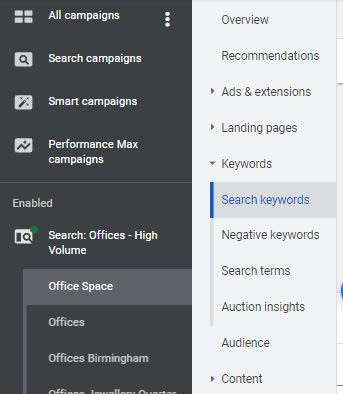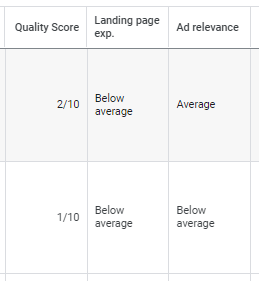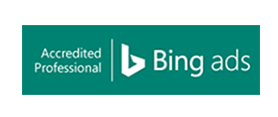Being visible at the top of Google is all but essential for businesses that are serious about their marketing in 2022 and beyond. However, getting results without tanking your profitability can be difficult.
In this post, we are going to look at 5 ways how to save money and improve results from your Google Ads.
Objective
It is easier to hit a goal if you know what you are aiming at. So, your first job is to set an aggressive, yet achievable goal for optimising your Google Ads PPC.
I would recommend the following goal:
Your goal is as follows:
- Double your total leads
- Halve your cost per lead
- Achieve this within 90 days
You then use this as a benchmark for your Google Ads PPC optimisation efforts.
When setting goals it always helps to check if they pass the muster as a SMART goal:
Specific – clearly defined so we know if we are getting there
Measurable – can we measure success?
Achievable – is this realistic?
Relevant – will this goal help grow your business?
Time-Based – can you set a time limit so if this is not working you can change tack?
The goal specified above, which you are free to modify to your situation, is specific, measurable and time-based. Also, based on our experience of 1000s of ad accounts, this is often easily achievable.
Think about it like this:
- You spend £10 per day
- This generates on average one lead per day
- Lead cost is £10
We want that £10 to generate two leads
- Spend £10 per day
- Generate 2 leads per day
- Lead cost is £5
This can sound unbelievable but in most cases, this is a conservative goal that is easily achievable with some smart optimisation and some good old-fashioned hard work.
Ready? The following tips will help you hit that goal.
5 Google Ads Management Tips
Here we have five tips that can all cut costs and improve results.
Results towards your goal are cumulative. Increase performance by 10% with each tip. Take your cost per lead from £10 to £9 with tip 1 and you are well on your way. Do the same with each of the remaining 4 tips and you are on your way to becoming a PPC Jedi.
With that in mind, I would suggest you work on one tip at a time. Get that 20% improvement dialled in and move on to the next tip.
We would generally recommend working on one at a time, getting the results dialled in and then moving on.
Then, when you have worked through all of these tips, simply loop back around and go.
Often, you may take a cyclic approach and work through the tips and then start again at the beginning – PPC optimisation is never finished!
Sometimes, working through all tips and then starting again will generate the best results.
It is important to note that high-performing ads are built on top of well-put-together businesses. So, some of what we recommend will be work you need to do outside of Google Ads, but we will provide links in the references below the article to any exercises.
Great results are not built on shortcuts. Great results come to those who know what they are aiming at and are willing to do the work. Follow all the recommendations here and you will see results – if not, we will audit your account and outline what you need to do for free.
If you are too busy and still want to improve results, get in touch for a free PPC Account Audit and Strategy Plan. This will show you exactly what you need to focus on to hit your goals and make Google Ads work for your business.
Ready? Let’s dive into the first tip.
1. Write High-Performing Ads
Why should I use you rather than your competitor? If you can’t answer this question you have a problem. If your ads don’t clarify this then you are in trouble. If you don’t stand out from the crowd, you have a problem. All the above? Then you really have some work to do here.
Your ads, whilst often just phoned in, are the most important part of your account. Your customers interface with you through your ads. In many cases, improving your ad is the #1 thing that can help improve your results.
Some of the key factors to consider here are:
- Have clear and compelling brand messaging
- Clearly define your value proposition
- Have a strong, compelling call to action
- List features and benefits to the customer
- Utilise special offers
- Use emotion and logic in your ad copy
- Upgrade to responsive search ads
We expand on all of these points and more in our article on How to Write High-Performance Google Ads. Review that article and put the recommendations to work and you will see improved results.
Further Reading:
How to Write High-Performance Google Ads
2. Use Single Keyword Ad Groups (SKAGs)
The true power of Google Ads is in the specificity of the targeting.
You can show ads to people who search for a specific search term in a specific location.
Yet, many ad campaigns use loose (broad) keyword matching and show a generic ad for a series of loosely related search terms. This is not the way.
You want to show highly targeted ads for a small number of highly relevant keywords. In fact, in many cases, you will want to show a specific ad for an individual keyword.
You may have this keyword in a “phrase” and [exact] match so the reality is that ads will show for more than just one specific keyword. You will also want to ensure you are using negative keywords to keep this highly relevant.
To do this you first must understand keyword match types.
You then want to ensure you have a highly specific flow:
Search Keyword > Advert > Landing Page > Call to Action
If you have a highly laser-focused approach that focuses on single keywords and then has highly relevant ads and landing pages you will boost conversion rates.
The key here is to understand that results come from giving the customer what they are looking for and keeping everything highly specific.
With this approach, you are making each step of the process, from search to conversion, highly relevant to the user’s original search intent. This gives the user exactly what they are looking for with very little friction and will boost conversion numbers with ease.
A Note on Exact Match
In 2022 [Exact Match] is far from an exact match so be sure to review your search terms report and use plenty of negative keywords.
Further Reading:
- Understanding Keyword Match Types
- Google Ads Success Factors – Keywords, Ads, Landing Pages & Analytics
3. Review Quality Scores
Wouldn’t it be nice if Google told you exactly which bits of your ad account are not really working? You could then review those areas and figure out how to improve them.
Fortunately, this information is available – you just have to know where to look for it.
Viewing Quality Scores
To view quality scores you need to:
- Browse to an individual ad group and to the “Search keywords” tab

- Then click on the “Columns” button and select “Quality Score”

- Then select 3 quality score fields:
- Quality score
- Ad relevance
- Landing page experience

- View quality score in your reports

* In this small sample from this account, we can see that these keywords have poor quality scores, below average landing page experience and average ad relevance.
How To Use This Information
In theory, Google Ads gives us laser-targeted advertising:
- A user searches for a specific keyword
- The user then clicks on a highly relevant advert
- Which takes them to a specific landing page
Simple enough in theory.
In practice, though, things are often a little different.
Google Ads uses keyword match types which, in turn, show your ads for an ever broader range of related keywords.
So you may find that the keywords showing ads are not as specific as you initially hoped. In turn, your ads and landing pages are equally not so well lined up.
Quality score helps you diagnose this and look for ways to tighten things up, with the usual suspects being:
- Adding negative keywords
- Using tighter match types
- Subdividing keywords into more tightly focused ad groups
- Building exact match ad groups
Sometimes, it may just be that the keyword you thought was a great match is actually not all that you thought it may be.
Analysing your quality score like this will give you a clearer idea of how the search funnel is working from keyword (quality score) to your advert (ad relevance) and the landing page (landing page experience).
Quality scores can often identify the biggest opportunities for improvement in a Google Ads account (and certainly highlight the largest areas of wasted clicks and budget).
A Quick Note on Quality Scores
Don’t ignore quality scores.
Low quality scores point to areas of your account that are not working.
High quality scores reduce the cost-per-click whilst improving the position of your ads.
Google rewards advertisers who show relevant, well-targeted ads with more impressions, clicks, and a lower price per click (so you can save money here).
If you are driven on getting quality scores in the 9-10 range you will be generating new business at the best possible cost.
9-10: Excellent – good work you are buying traffic at the right price
7-8: Okay – could be some room for improvement with some gentle tightening
5-6: Baseline – huge room for improvement here
3-4: Problems – these keywords are costing you money and likely generating no results
1-2: Major problems – these keywords are likely strategically off and need major revisions
By reviewing quality scores each week and making sensible, common sense optimisations, you can build an account that delivers the goods at a price that won’t bleed you dry.
4. Review Competitive Metrics
There is another set of metrics that are crucially important to ensuring you develop and optimise your Google Ads and focus your budget where it can work the hardest – competitive metrics.
At first glance, competitive metrics seem complicated, however, they are a treasure trove of useful information that you can use to identify high and low-performance parts of your account.
You can then use this information to ensure you focus your budget where the results are and cut away clicks and impressions that are wasting money.
Keyword & Ad Group Level Competitive Metrics
These metrics are available at an ad group and keyword level of analysis.
- Search impression share – how often your ads showed vs how often they could have been based on your targeting
- Search top IS – how often your ads were in the top pack of ads
- Search abs. top IS – how often your ads were shown in the first place position
- Search lost IS (rank) – how often low ad rank prevented your ads from being shown
- Search lost top IS (rank) – how often low ad rank prevented your ads from being shown at the top of the search results
- Search lost abs. top IS (rank) – how often low ad rank prevented you from hitting the first position result
- Search exact match impression share IS – how often your highly matched keywords triggered an ad (vs ads triggered by a broader match)
- Click share – what percentage of available clicks you received based on your targeting
Campaign Level Competitive Metrics
These additional metrics are only available at a campaign level (in addition to the 8 above):
- Search lost IS (budget) – how often your ad was not shown due to a lack of budget
- Search lost top IS (budget) – how often your budget prevented your ad from appearing in the top set of results
- Search lost abs. top IS (budget) – how often your ad lost the absolute top spot due to budget
Enabling Competitive Metrics
Enabling competitive metrics is done by clicking on the “Columns” icon to show the options:

Then select the metrics you are most interested in:

How to Use Competitive Metrics to Optimise Your Account
You want to use the competitive metrics to find areas of the account that are working well and that you could expand.
Example
- Identify your best-performing ad group
- Review the search keywords
- Enable search impression share & click share
Where you have high-performing keywords that you don’t have 100% search impression share or 100% click share then look at what you can do to improve that.
Typically, to do this we would enable a few more competitive metrics:
- Search top IS
- Search abs. top IS
- Search lost IS rank
You can now start to build a picture of why you are not getting those clicks:
- Are your ads not at the top of the page?
- Are you losing due to ad rank?
- If so, you may need to improve quality scores or bids
You may also want to quickly review at a campaign level so you can identify if you are losing clicks due to budget.
We would then look to do a few things here:
- Invest more budget
- Trim areas of the account that don’t perform so well
By using these metrics you can clearly understand what parts of the account work, don’t work, why that is, and what you can do about it.
Dive into the competitive metrics – the opportunity to improve your account is vast.
Competitive Metrics in a Nutshell
If there are parts of your account that work really well and you are not maximising the number of impressions, clicks and conversions you are getting then you are leaving money on the table.
5. Landing Page Optimisation
It is tempting to spend all of your optimisation time on Google Ads but that would be missing what is often the most important part of your entire campaign – your landing page.
Better landing pages generate better engagement, lower bounce rates and, most importantly of all, more leads.
Better still, improving all these factors improves your quality scores and helps your ads show in better positions at lower prices. Win-win.
Key factors to consider for optimising landing pages:
- Relevance
Relevance is key. Relevance to your keyword. Relevance to your ad. Relevance to your customers’ needs and intent. Make your landing page as closely tailored as possible to your keywords and ads – think of the SKAGs approach mentioned above.
- Credibility & Trust
Ensure you clearly illustrate your credibility and trust. This customer may never have heard of you before so do what you can to clearly illustrate that you can be trusted.
- Ease of Use
Consider the devices your customers use and ensure you tailor a landing page that makes it easy for them to review your offering and to get in touch.
- Speed, Reliability & Accessibility
Ensure your website is technically accessible, fast, and works well on all devices. Also, make sure it is available 24/7. That bargain basement £5.00 per month web hosting makes absolutely no sense when you are sending £10.00 clicks from Google Ads – get fast and reliable hosting in place!
Practical Tips
- Send your customers to the most relevant landing page on your site – don’t expect them to browse around and find the right page, it is easier for them to click back and go to the next site.
- Tailor landing pages around the keywords you target and that feature in your ads (think about using SKAGs with individual landing pages that are finely tuned to each ad group).
- Have a single goal for your page that matches the intent behind your ad group’s keyword. If you are selling boiler repair send the user to a page that focuses just on boiler repair and why they should use you for boiler repair – don’t try and squeeze in other products and services – keep it focused!
- Use consistent CTAs (calls to action) across your ads and your landing page so the customer knows exactly what they should do next.
- Use standard conversion optimisation best practices – that is make page elements like CTAs the biggest and most stand-out elements on the page.
- You are likely just one service provider amongst many so get the marketing strategy in place before the marketing tactics. Have consistent brand messaging. Have a clear value proposition so the customer knows why to use you.
- Clearly illustrate all of your credibility factors – awards, memberships of trade bodies, accreditations, experience, testimonials & reviews. Get it all on the page to make you the obvious choice.
- Ensure all copy is of a high-quality and inspires trust.
If you ensure each of these areas is as good as it can be then you will generate more engagement, higher time on page, improved quality scores, and more leads. Often, landing pages alone can double conversion rates so you can halve your cost per lead and double conversion rates.
Summary
Hopefully, this has helped you see 5 relatively simple ways you can optimise your ad accounts. If you have any questions or you would like a free audit of your Google Ads PPC account to show you the top 5 things you should do then get in touch.
Free Google Ads Audit – get in touch.
Reference & Further Reading
- Brand Story – https://buildingastorybrand.com/
- Value Proposition Canvas – https://www.strategyzer.com/canvas/value-proposition-canvas
- Understanding Keyword Match Types – https://www.bowlerhat.co.uk/understanding-keyword-match-types-for-google-ads/
- Google Ads Success Factors – https://www.bowlerhat.co.uk/google-ads-the-4-key-success-factors/






